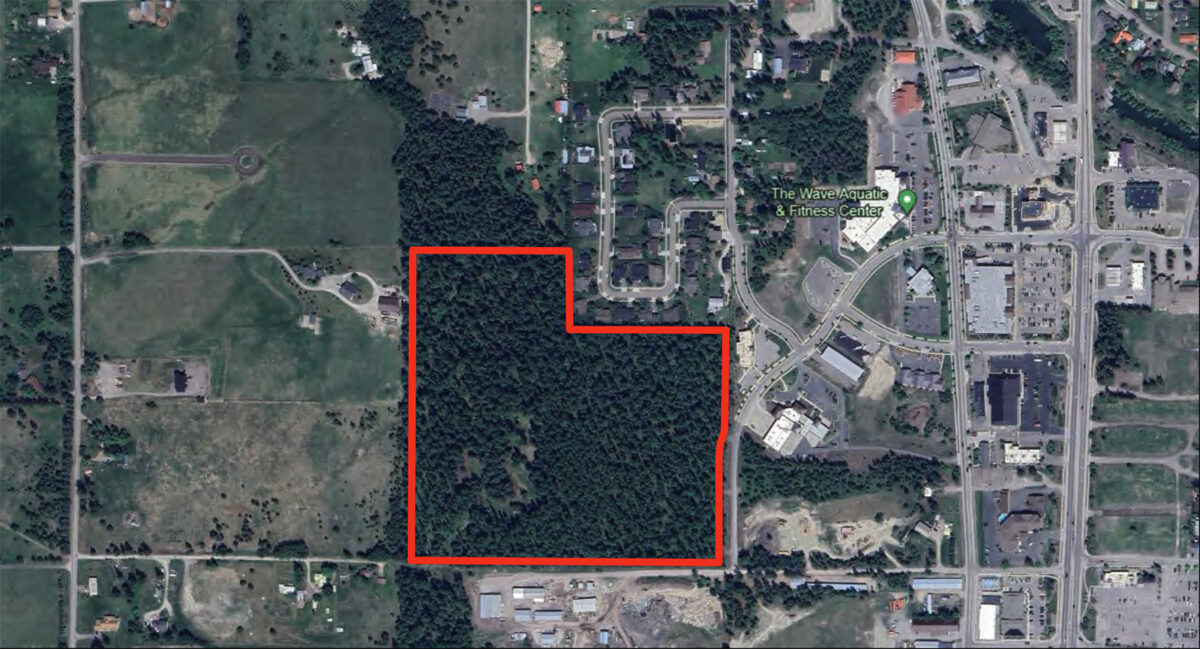Whitefish Council Approves 73-Unit Subdivision
The council’s vote ran counter to the recommendation of the city’s community development board, which voted against the project in March despite city staff recommending conditional approval
By Mike Kordenbrock
The Whitefish City Council earlier this month voted in favor of a developer’s requests to amend the city’s growth policy and change the zoning on a related parcel of land to clear the way for building a 73-unit subdivision consisting largely of single-family homes.
Called Whitetail Ridge, the development was brought to the council by Doug Siderius and Al Schellinger of Whitetail Ridge Holding. It’s planned for a 34-acre piece of land off Flathead Avenue directly west of the Whitefish Fire Department and south of Sawtooth Drive and the O’Brien Bluffs subdivision. About one-third of the property will be reserved for parkland, which will encompass existing wetlands on the property. The subdivision will have 59 single-family homes and 14 townhome sublots consisting of seven townhomes.
The version of the project that went before the council on June 3 was slightly different from what the Whitefish Development Board reviewed and rejected at a meeting in March. Notably, the new version reduced the number of housing units from 77 to 73 in order to accommodate for public right of way along the southern property line so that the developer can extend West 18th Street. The new version of the project also calls for constructing a temporary T-turn on a portion of road along with gated emergency access to neighboring Sawtooth Drive.
The zone change request approved by the council splits the property into one-family and two-family residential districts. Prior to the zone change approval, the land, which was annexed by the city earlier this spring, had been split between county single-family residential and heavy industrial zoning.

The council’s vote ran counter to the recommendation of the city’s community development board, which voted against the project in March despite city staff recommending conditional approval. That 4-2 vote against the project hinged on the belief that the project did not support the growth policy’s vision as it relates to affordable housing, did not support environmentally sensitive areas, and did not support an efficient transportation system.
Eric Mulcahy, a land-use planner for Sands Surveying, who presented on behalf of the developer at the June 3 council meeting, said they had reviewed the revised staff report recommending approval, and agreed with its findings and conditions of approval. Mulcahy said he did not agree with the community development board’s findings on affordable housing.
“We don’t agree at all with the planning commission’s findings on the growth policy amendment regarding the affordable housing, because it’s not really a requirement of the growth policy,” Mulcahy said.
He told the council that the project was designed to be compatible with surrounding neighbors and neighborhoods.
“Rather than trying to put more density into this we chose to primarily have 10,000 square foot lots except for that southeast corner,” Mulcahy said.
Siderius also addressed the council to provide background on the property’s history, and more context for how the project came together. As Siderius explained, the Quiram family has owned the property since the 1960s, and they asked him to develop the property in a way the family could be proud of, including by protecting the wetland, leaving trees where possible, and dedicating a path to the family.
Siderius also vouched for the project based on his own family’s deep history in the Flathead going back to the early 20th century, and their reputation.
“When we proposed this, we knew our name’s going to be tied to it. We’re not going to do something that’s going to disgrace our families and the past that we’ve had and the reputation that we’ve had,” he said.
Cameron Blake and Richard Hildner, who are both on the board of directors for Flathead Families for Responsible Growth, addressed the council separately during public comment and critiqued the project’s lack of density and affordability.
The council voted to approve the developer’s requests by a 3-1 margin, with Councilor Frank Sweeney casting the only votes in opposition. Councilors Rebecca Norton and Andy Feury were absent from the meeting.
Sweeney prefaced his “no” votes by reminding the council that they made no promises to the developer about zoning or the growth policy when they approved annexing the property.
“I think it’s important for us to consider whether or not under these circumstances given this proposal, whether we want to adopt a zone change or a growth policy change that will not give us what we need for this community, which includes some affordable housing,” Sweeney said. “Remember, we have control over whether or not we want to make a growth policy change at this particular hour. Keep in mind, all of us, that we are also in the middle of a reexamination of our growth policy that’s going to take place over the next year or so. And I’m not sure that this kind of development will be part of that growth policy.”
Councilor Giuseppe Caltabiano, who voted in favor of all three requests from the developer, said that while he normally respects the work of the development board, he sees their decision on the development as a “mistrial.”
“I think leaving that area as it is, it’s riskier, and more potentially damaging to the community with the industrial zone,” Caltabiano said.
Councilor Ben Davis explained that while he does not take modifying the growth policy lightly, he doesn’t see the value to the city and neighboring community in having a portion of this property to be set aside for heavy industrial use. Davis also said that while calls for affordable housing are near and dear to him, he believes affordable housing needs to be supported on a broader policy level.
“I just think trying to apply this in a piecemeal way onto a project like this is very problematic,” Davis said.
Ahead of his final vote to approve the preliminary plat, Councilor Steve Qunell said he was sympathetic to calls for greater density, but that it wouldn’t fit there given the surrounding zoning. He also reminded the council that the state had taken away its ability to require affordable housing.
“When we have an opportunity to approve 73 single-family homes I’m skeptical,” Qunell said. “I’m skeptical, but I’m going to put my faith in a guy like Doug Siderius and Mr. Schellinger way more than I’m going to put it into an outside development company that comes from the outside and wants to build something here.”